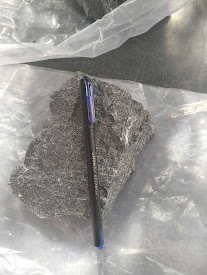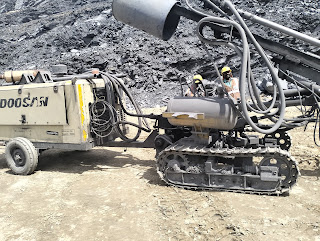INTRODUCTION ABOUT BARYTES DEPOSITS:
Generally, the rock units met within the region are tuff, barytes with intercalated thin bands of tuff and dolomite. As regards the granular barytes, field evidence suggested a sedimentary origin. Chemical precipitation of volcanic exhaustives under submarine or sub-aqueous conditions is considered responsible for the deposition of barytes. Barytes occur as bedded deposits that have undergone folding and cross-folding. Barytes occurs generally below the tuff cover. Theoreis invariably associated with thin bands of tuff. Low-grade barites having a specific gravity of 3.8 to 4.2 occur at the top followed at depth by a granular variety comprising high-grade barytes with a specific gravity of 4.22 and above.
PURPOSE OF FIELD VISIT:
To understand the Geological setting of the Baryte deposits of mangampeta area.
Aerial view of Mangampet Barytes
OCCURRENCE:
Occurrences of barites in Mangampeta area are considered to be of sedimentary origin. The radiating platy aggregate of barytes containing inclusions of euhedral crystals, microlites un- altered feldspar, outlines of the wavy barytes lapalli, angular to sub- angular nature of quartz grains exhibiting embayed margins, the presence of minute darkdust-like particles in quartz and barites grains sagging of the tuff laminae beneath the quartz, pyrite, and barytes lapalli indicate a pyroclastic origin of the crystal and devitrified glass tuffs and lapalli (rosette) barytes.
The granular barytes are formed by the precipitation of the volcanic exhalation under sub-marine/sub-aqueous conditions.
The intercalations of the rosette barites with in the granular barites and vice-versa may be attributed to deposition of pyroclastic material within the chemical sedimentary type. The intimate association of the barytes derived from the pyroclastic and exhalation phases of volcanic activity indicates them to be the products of the same volcanism.
DISTRIBUTION:
Andhra Pradesh produce over 98% of barites in India. In ap barites are distributed in cuddapah, Kurnool, Anantapur, Nellore districts.
MININGLOCATIONDETAILS:
The mangampet deposit in the kadapa district of Andhra Pradesh is the single largest baryte deposit in the world. It is located in the 14°01ˈ38” N and 79°18ˈ51” E a mangampeta village in Rajampeta taluk in Cuddaph district.
GEOLOGY (CUDDAPAH SUPER GROUP):
The Mangampet barites deposit occurs in the form of two lentoid bodies within the tuff of Pullampet Formation, Nallamalai Group of the Cuddapah Super Group. The lens occurring near Mangampet village is termed as Northern lens and the other at 700m south of it is termed as the Southern (smaller) Lens.
Bedded Barytes of Mangampet is confined to the Northern lens of the Mangampet barites deposit. The Mining Lease area forms apart of the Northern Lens (measuring 1220 m in the north-south direction and 900m in the east-west direction) of the Mangampet Barytes Deposit. It is the single largest and unique bedded Barytes deposit of its kind in the world.
Regional
map Cuddapah basin showing Mangampeta Barytes
ORIGIN/GENESIS:
Mangampeta baryte deposits were formed in a generally restricted and reducing marine Environment accompanied by hydrothermal activity and rapid sedimentation
→Syngenetic cracks, Syngenetic faults.
→Volcanic origin for the baryte deposit mainly from the presence of "tuffbed"
intercalations. These intercalation were reported as black Shale therefore giving a sedimentary origin. Bedded barite deposits consist of grey granular barite intercalation with black shale beds. Baryte beds overlie dolostone. Evidence of folding and faulting - Dolostone shows brecciation, indicative of brittle deformation.
GEOLOGICAL SUCCESION:
⮚ Devitrified glass tuff
⮚ Devitrified glass tuff with quartz lapilli , Devitrified glass tuff with barite lapilli Granular barite
⮚ Black devitrified glass tuff containing carbon Crystal tuff,
⮚ Dolomite.
⮚ Above showing the geological succession of the mangampeta barytes deposit from bottom dolomite to top devitrified glass tuff.
LITHO UNITS
⮚ Soil.
⮚ Quartz veins.
⮚ Tuff (partly weathered) Carbonaceous tuff with quartz lapilli Tuff with quartz and barytes lapilli Tuff with barytes lapilli. Alternate bands of lapilli baryles and tuff Lapilli barytes.
⮚ Granular barites Carbonaceous tuff.
⮚ Dolomite with thin black tuff bands.
⮚ Alternate grey and black tuff with thin dolomite Dolomite.
GRADES AND QUANTITIES:
Chemical grade A--85%-fine grain – [specific gravity above 4.2]
Fine grained
Chemical grade B– [specific gravity 4.10-4.]
Medium grain
Samples showing the grades and grain size which was collected in the field The top grade barytes are occurred in the bottom of the mines and where the low- grade deposits are occurred in the top of bedding along with the shale Specific gravity is the main property to identify the grade of the baryte deposits.
TYPES OF BARYTES:
Baryte is a mineral consisting of barium sulfate (BaSO4) Baryte is generally white or colorless, and is the main source of the element barium. The baryte group consists of baryte, celestine (strontium sulfate), anglesite (lead sulfate), and anhydrite (calcium sulfate). Baryte and celestine form a solid solution (Ba,Sr)SO4.
PHYSICAL PROPERTIES:
|
Colour |
Colourless,
white,Grey |
||
|
Crystal habit |
Tabular parallel to base, fibrous, nodular to massive
|
||
|
Cleavage |
Perfect cleavage parallel to base and prism faces |
||
|
Fracture |
Irregular/uneven |
||
|
Tenacity |
Brittle |
||
|
Hardness |
3-3.5 |
||
|
Luster |
Vitreous,pearly |
||
|
Streak |
White |
||
|
Specific gravity |
4.3–5 |
|
|
|
Density |
4.48g/cm3 |
|
|
In the Mangampeta, barytes of volcanic origin occurs as thick-bedded deposit within the Pullampet Shale. Four types of barytes are found viz., grey granular.
PYRITES ASSOCIATED BARYTES:
Strontium (Sr) isotope analyses of barite and associated pyrite-bearing carbonaceous tuff are carried out. to understand the nature of mineralizing fluids for Mangampet barite deposit, which is one of the largest barite deposits in the world. "Sr/Sr ratios of barite and pyrite-bearing carbonaceous tuff range. from 0.70754 to 0.728951 and 0.72969 to 0.819633. respectively. These ratios, high compared to the Proterozoic Sea water, preclude the well-mixed sea water or mantle to be the immediate source of Sr, and by association of barium (Ba). We infer that Sr and Ba were derived from the Cuddapah sediments by sedimentary exhalative process. This is further substantiated by the fluid inclusions in the barites which yield a limited range of salinity, but a wide range of homogenization temperatures (from300°C to 120°С). Indicating that ore deposition took place due to cooling of hydro thermal fluid with limited mixing of ambient sea water, thereby preserving the salinity as well as Sr isotope ratios of the ore fluid. The relative
sulphur isotope ratios (5S) reported from the barites of Mangampet fall in narrow range 41.3-45.5%, where as the 8 S of pyrites falls in two distinct categories. Pyrites with S close to 0% are interpreted to have formed by magmatic S acquired by the hydrothermal fluid, where as pyrites with 8 S values ranging from 8.1% to 38.8%.
In the formation of Barytes two main theories are involved which are Barium rich Volcanism – Mixed with sulfide
● Barium rich Sulphur theory
Image showing the Double plunging folds
Strike direction - North to south
Dip North direction –East to south
MINING METHODOLOGY – Open cast mining
open cast mining
Open-pit mining, also known as opencast mining, is a surface mining technique that extracts minerals from an open pit in the ground. Open-pit mining is the most common method used throughout the world for mineral mining and does not require extractive methods or tunnels.
EQUIPMENTS AND MACHINARY
Drilling machine
A total station (TS) or total station theodolite (TST) is an electronic/optical instrument used for surveying and building construction. It is an electronic transit theodolite integrated with electronic distance measurement (EDM) to measure both vertical and horizontal angles and the slope distance from the instrument to a particular point, andanon-board computer to collect data and perform triangulation calculations.
BenchHeight- 10m
Every 16 meter – 1 meter rise [1 in 16] First leveling–North to south direction
Bench Marks - Disturbance Gradient =Horizontal distance / Level distance
USES:
World wide, 69–77% of barite is used as a weighting agent for drilling fluids in oil and gas exploration to suppress high formation pressures and prevent blow outs. The deeper the hole, the more baryte is needed as a percentage of the total mud mix. An additional benefit of barite is that it is non-magnetic and thus does not interfere with magnetic measurements taken in the borehole, either during logging-while drilling or in separate drill hole logging. Baryte used for drilling petroleum wells can be black, blue, brown or grey depending on the ore body.
MINOR USES:
Baryte is used in added-value applications which in clued filler in paint and plastics, sound reduction in engine compartments, coat of automobile finishes for smoothness and corrosion resistance, friction products for automobiles and trucks, glass ceramics, and medical applications (for example, a barium meal before a contrast CT scan). Baryte is supplied in a variety of form sand the price depends on the amount of processing; filler applications commanding higher prices following intense physical processing by grinding and micronizing, and there are further premiums for whiteness and brightness and color. It is also used to produce other barium chemicals, notably barium carbonate which is used for the manufacture of LED glass for televisions and computer screens (historically in cathode ray tubes); and for dielectrics.
Exporter type – raw material export Pulverizing mills - powder Chemicals units - separations of Ba & S to form Barium compounds
As the world's largest barytes deposit, Mangampet reflects the immense potential of India's mineral resources. Dive deeper into the wonders of geology by exploring our other posts!





.jpeg)





I loved your work, Ma'am. Very knowledgeable blog. It was insightful for me ❤🥰.
ReplyDelete